Research on a Multi-Species Combined Habitat Suitability Assessment Method for Various Fish Species
Abstract
:1. Introduction
- To propose a Multi-Species Combined Habitat Suitability Index (MCHSI) evaluation model, applicable to the downstream of Gongzui Dam, and conduct cross-validation based on the actual distribution of fish to validate the model’s applicability and reliability.
- Assess the MCHSI of study section under different flow conditions and analyze its sensitivity.
- Based on the sensitivity analysis result, to quantify the evolution process of high-sensitive regions with hydrological rhythms, forming a set of quantitative analysis methods for the evaluation of suitable habitat.
2. Materials and Methods
2.1. Study Area
2.2. 2-D Hydrodynamic Model
2.2.1. Hydraulic Module
2.2.2. Definite Conditions
2.2.3. Verification of Simulation Result
2.3. Target Fish
2.3.1. Composition of Catch and Suitability Curve of Target Fish
2.3.2. Cluster Analysis
2.4. Calculation of Weight Matrix
- (1)
- Construct a weight matrix based on the proportion of target species (Table 3).
- (2)
- Calculate the suitability (SIT,D, SIT,V, SIC,D, SIC,V, SIE,D, SIE,V) of different fish species based on the observed water depth and current speed, and construct matrix S combined with the proportion of fish population:
- (3)
- Construct a weight matrix W, whose initial values can be randomly assigned:
- (4)
- The model assumes a linear relationship between the number of fish in the grid and its MCHSI value, that is, a grid with a large number of fish also has a larger MCHSI value; the grid with a MCHSI value of 0 also has a fish population of 0.
2.5. WUA Construction Procedure
2.6. Sensitivity Analysis
3. Results
3.1. Fish Distribution
3.1.1. Characteristics of Fish Distribution
3.1.2. Verification of MCHSI Model
3.2. Simulation Results of Combined Suitability Index
3.2.1. Distribution of MCHSI
3.2.2. Results of WUA
3.2.3. Results of Sensitivity Analysis
3.2.4. Migration of Suitable Habitat Patches
- (1)
- Category I habitat patches (Figure 11a): MCHSI is greater at low flow conditions and decreases rapidly as flow increases, so category I patches are suitable fish habitats at low flows (<800 m3/s). It is mainly distributed near the river bank. The category I habitat patches in the study river section have a total area of about 11,424 m2.
- (2)
- Category II habitat patches (Figure 11b): MCHSI is larger under moderate flow conditions (1000 to 2000 m3/s) and smaller under other conditions, and is mostly located in areas close to the riverbanks, which are areas of suitable habitat for fish under moderate flow conditions. The category II habitat patches in the study reach have a total area of about 9956 m2.
- (3)
- Category III patches (Figure 11c): MCHSI increases with flow and is larger under high flow conditions (>2000 m3/s), and this category of patches is small and occurs only in portions of the right bank of the upstream and downstream banks of the reach, totaling approximately 1268 m2.
4. Discussion
4.1. Reasons for Errors in the MCHSI Model
- The fish species selected for this study accounted for 61.9% of all species surveyed in the catch, and the number of fish accounted for 84.3% of the total catch; some fish species were not included in the study due to a lack of information on the suitability curves, and thus would have contributed to a certain degree of error in the calculation of the MCHSI.
- There are errors in the fish hydroacoustic detection results, so the number of fish signals in the grid may have some bias, leading to errors in the derivation of the weighting matrix.
- The simulation error of the flow field in the study river section can also cause the deviation of the MCHSI in some areas of the river, resulting in a lower MCHSI in some areas with fish distribution.
4.2. Changing Characteristics of WUA
4.3. Migration Patterns of Habitat Patches
4.4. Advantages and Disadvantages of the Model
5. Conclusions
- (1)
- The evaluation results of the MCHSI model proposed in this study are consistent with the actual distribution of fish, and can better quantitatively evaluate the habitat distribution and suitability of multiple fish species in the reach.
- (2)
- Since the research objects all belong to aquatic species that adapt to low water depth and flow velocity, the WUA of the study reach decreases as the flow increases, and the decreasing rate is positively correlated with the increase rate of water depth and flow velocity.
- (3)
- Sensitivity analysis extracts the areas where the suitability of the reach is significantly affected by changes in flow conditions, and reveals the migration and evolution process of habitat patches with the flow: with the increase in flow, the distribution of habitat patches are highly correlated with the evolution trend of low water depth and low flow velocity areas in the reach. The habitat patches are distributed in the nearshore area, and with the increase in flow, they tend to concentrate in the low flow velocity areas downstream with a larger river width. The evolution process of habitat patches is in line with the suitability curve of the research fish objects, and the sensitivity analysis method proposed in this study can better quantify and evaluate the migration and evolution process of suitable habitat patches for multiple species.
- (4)
- This model requires accurate species suitability curve data, and currently, many species, especially endangered and rare species, have difficulty in studying their suitability curves, which limits the application of this model. Future research directions can consider the relationship between predation, competition, or cooperation among multiple species, and combine the quantity and distribution characteristics of species to analyze the evolution process of the quantity and distribution of various groups, revealing the selection mechanism of water conservancy operation on the evolution direction of population structure in river sections. The research results can also be used to predict the quantity and distribution of fishery resources.
Author Contributions
Funding
Institutional Review Board Statement
Informed Consent Statement
Data Availability Statement
Conflicts of Interest
Abbreviations
| Abbreviations | Expansions |
| WUA | Weighted Usable Area |
| PHABSIM | Physical Habitat Simulation System |
| MCHSI | Multi-Species Combined Habitat Suitability Index |
| ADCP | Acoustic Doppler Current Profiler |
References
- Jager, H.I.; Chandler, J.A.; Lepla, K.B.; van Winkle, W. A theoretical study of river fragmentation by dams and its effects on white sturgeon populations. Environ. Biol. Fishes 2001, 60, 347–361. [Google Scholar] [CrossRef]
- Esguícero, A.L.; Arcifa, M.S. Fragmentation of a Neotropical migratory fish population by a century-old dam. Hydrobiologia 2010, 638, 41–53. [Google Scholar] [CrossRef]
- Lange, K.; Meier, P.; Trautwein, C.; Schmid, M.; Robinson, C.T.; Weber, C.; Brodersen, J. Basin-scale effects of small hydropower on biodiversity dynamics. Front. Ecol. Environ. 2018, 16, 397–404. [Google Scholar] [CrossRef]
- Vörösmarty, C.J.; McIntyre, P.B.; Gessner, M.O.; Dudgeon, D.; Prusevich, A.; Green, P.; Glidden, S.; Bunn, S.E.; Sullivan, C.A.; Liermann, C.R.; et al. Global threats to human water security and river biodiversity. Nature 2010, 467, 555–561. [Google Scholar] [CrossRef]
- Fronk, B.M.; Neal, R.; Garimella, S. Evolution of the transition to a world driven by renewable energy. J. Energy Resour. Technol. 2010, 132, 021009. [Google Scholar] [CrossRef]
- Mischke, P.; Karlsson, K.B. Modelling tools to evaluate China’s future energy system–a review of the Chinese perspective. Energy 2014, 69, 132–143. [Google Scholar] [CrossRef]
- Spence, R.; Hickley, P. The use of PHABSIM in the management of water resources and fisheries in England and Wales. Ecol. Eng. 2000, 16, 153–158. [Google Scholar] [CrossRef]
- Nagaya, T.; Shiraishi, Y.; Onitsuka, K.; Higashino, M.; Takami, T.; Otsuka, N.; Akiyama, J.; Ozeki, H. Evaluation of suitable hydraulic conditions for spawning of ayu with horizontal 2D numerical simulation and PHABSIM. Ecol. Model. 2008, 215, 133–143. [Google Scholar] [CrossRef]
- Miao, Y.; Li, J.; Feng, P.; Dong, L.; Zhang, T.; Wu, J.; Katwal, R. Effects of land use changes on the ecological operation of the Panjiakou-Daheiting Reservoir system, China. Ecol. Eng. 2020, 152, 105851. [Google Scholar] [CrossRef]
- Wen, X.; Lv, Y.; Liu, Z.; Ding, Z.; Lei, X.; Tan, Q.; Sun, Y. Operation chart optimization of multi-hydropower system incorporating the long-and short-term fish habitat requirements. J. Clean. Prod. 2021, 281, 125292. [Google Scholar] [CrossRef]
- Dai, L.; Wang, Y.; Dai, H.; Li, W.; Zheng, T.; Zhang, Q. Assessment of Environmental Flow Requirements for Four Major Chinese Carps in the Lower Reaches of the Jinsha River, Southwest China. Front. Ecol. Evol. 2022, 10, 318. [Google Scholar] [CrossRef]
- Ban, X.; Guo, Z.; Xiong, X.; Liu, X.Q.; Ma, Y.X.; Wang, H.Z. Applying physical habitat model of zoobenthos in typical reaches of the Yangtze River. J. Hydraul. Eng. 2020, 51, 936–946. [Google Scholar]
- O’Keefe, D.M.; O’Keefe, J.C.; Jackson, D.C. Factors influencing paddlefish spawning in the Tombigbee Watershed. Southeast. Nat. 2007, 6, 321–332. [Google Scholar] [CrossRef]
- Zhou, J.; Zhao, Y.; Song, L.; Bi, S.; Zhang, H. Assessing the effect of the Three Gorges reservoir impoundment on spawning habitat suitability of Chinese sturgeon (Acipenser sinensis) in Yangtze River, China. Ecol. Inform. 2014, 20, 33–46. [Google Scholar] [CrossRef]
- Wang, P.; Shen, Y.; Wang, C.; Hou, J.; Qian, J.; Yu, Y.; Kong, N. An improved habitat model to evaluate the impact of water conservancy projects on Chinese sturgeon (Acipenser sinensis) spawning sites in the Yangtze River, China. Ecol. Eng. 2017, 104, 165–176. [Google Scholar] [CrossRef]
- Deng, Q.; Zhang, X.; Zhao, Z.; Tang, W. Conservation and restoration of riverine spawning habitats require fine-scale functional connectivity and functional heterogeneity. Sci. Total Environ. 2023, 857, 159571. [Google Scholar] [CrossRef]
- Khwairakpam, E.; Dhawan, B.; Sivakumar, K.; Johnson, J.A. Habitat suitability modeling of a conservation-significant fish species of the Kosi River, Uttarakhand, India. River Res. Appl. 2023, 39, 189–199. [Google Scholar] [CrossRef]
- Booker, D.; Dunbar, M. Application of physical habitat simulation (PHABSIM) modelling to modified urban river channels. River Res. Appl. 2004, 20, 167–183. [Google Scholar] [CrossRef]
- Yao, W.; Rutschmann, P. Three high flow experiment releases from Glen Canyon Dam on rainbow trout and flannelmouth sucker habitat in Colorado River. Ecol. Eng. 2015, 75, 278–290. [Google Scholar] [CrossRef]
- Liu, J. Preliminary Study on the United Dispatching for the Cascade Hydropower Stations in Dadu River Basin. Water Power 2007, 33, 5–8. [Google Scholar]
- Chen, B.; Wang, D.; Zhang, D.; Peng, Q. Conservation of aquatic ecosystems and fish species during hydropower development in the river basin: Case study for the Dadu River Basin. Water Resour. Hydropower Eng. 2022, 53 (Suppl. 1), 347–357. [Google Scholar]
- Huai, W.; Zhao, Z.; Tong, H.; Zhang, C. Numerical simulation on flood in downstream of Weihe River and flooded area (I)—Mathematic model and its calculation method. Eng. J. Wuhan Univ. 2003, 36, 10–14. [Google Scholar]
- Liu, Y.; Jin, Z.; Lin, C.; Tan, J.; Wei, L. Application of Multi-dimensional Quantization System for Target Fish Species Based on Comprehensive Weighting-TOPSIS Model in Nandu River Basin. J. Hydroecol. 2022, 1–20. [Google Scholar] [CrossRef]
- Li, D.; Ke, S.; Xu, J.; Jiao, Y.; Bai, T.; Cheng, B.; Tao, Y.; Wang, Y.; Shi, X.; Sun, Q. Downstream migration of Juvenile fish at Songxin Hydropower Station on the HeishuiRiver, a tributary of the Jinsha River. J. Lake Sci. 2023, 35, 958–997. [Google Scholar]
- Deng, X.; Wang, W.; Fang, Y.; Huang, D. Fish Community Structure in the Leshan Section of Dadu River. J. Hydroecol. 2020, 41, 53–61. [Google Scholar]
- Wang, W.; Fang, Y.; Yang, Z.; Huang, J.; He, C.; Du, X. Fish community structure and diversity in the leshan section of Dadu River. J. Hydroecol. 2023, 44, 62–69. [Google Scholar]
- Chen, M.; Wu, D.; Ji, X.; Lang, J. The Engineering Design of Artificial Fish Spawning Field in Lianghekou Hydropower Station of Yalong River. Sichuan Environ. 2018, 37, 83–89. [Google Scholar]
- Edwards, E.A.; Twomey, K. Habitat Suitability Index Models: Common Carp; Western Energy and Land Use Team, Office of Biological Services, Fish and Wildlife Service, US Department of the Interior: Fort Collins, CO, USA, 1982. [Google Scholar]
- Hou, J.; Wang, X.; Miao, L.; Ding, W.; Wu, M. Technical Guide to the Instream Flow Incremental Methodology, 1st ed.; China Water and Power Press: Beijing, China, 2021. [Google Scholar]
- Yang, Z.; Zhang, Y. Comparison of methods for ecological and environmental flow in river channels. Chin. J. Hydrodyn. 2003, 18, 294–301. [Google Scholar]
- Wang, X.; Yan, Z. Effect of Hydraulic Characteristics of Confluent Channel on Physical Habitat for Fish Communities. J. Tianjin Univ. (Sci. Technol. ) 2008, 41, 204–208. [Google Scholar]
- Zhang, Y.; Zhou, J.; Zhang, B.; Gao, F.; Ma, B. Pollution Evaluation of Toxic Heavy Metals in the Sediments of Songhua River. J. Hunan Univ. (Nat. Sci. ) 2015, 42, 113–118. [Google Scholar]
- Zhu, Y.; Du, H.; Qiu, B.; Wang, C.; He, S.; Jiang, Z. Study on Characteristic Curve Correction of Cascade Hydropower Stations in the Middle and Lower Reaches of Dadu River. Water Resour. Power 2023, 41, 61–64. [Google Scholar]
- Garcia-Rodriguez, E.; Martinez-Austria, P.F.; de Jalon-Lastra, D.M.G.; Ochoa-Franco, L.A. Determination of the weighted usable area for Salmo trutta species in a stretch of the Lozoya River, Spain. Ing. Hidraul. Mex. 2009, 24, 19–32. [Google Scholar]
- Chang, Y.L.; Hsieh, T.Y.; Chen, C.H.; Yang, J.C. Two-Dimensional Numerical Investigation for Short- and Long-Term Effects of Spur Dikes on Weighted Usable Area of Rhinogobius candidianus (Goby). J. Hydraul. Eng. 2013, 139, 1297–1303. [Google Scholar] [CrossRef]
- Zhao, Y.; Zhou, J.; Zhang, H.; Bi, S.; Zhang, Y. lmpact of Three Gorges reservoir operation with ahead impounding water on Acipenser sinensis spawning. J. Hydroelectr. Eng. 2013, 32, 83–89. [Google Scholar]
- Li, P.; Liang, C. Simulation for the impact of floodplain woodland development to fish habitat area. Resour. Environ. Yangtze Basin 2016, 25, 1286–1291. [Google Scholar]

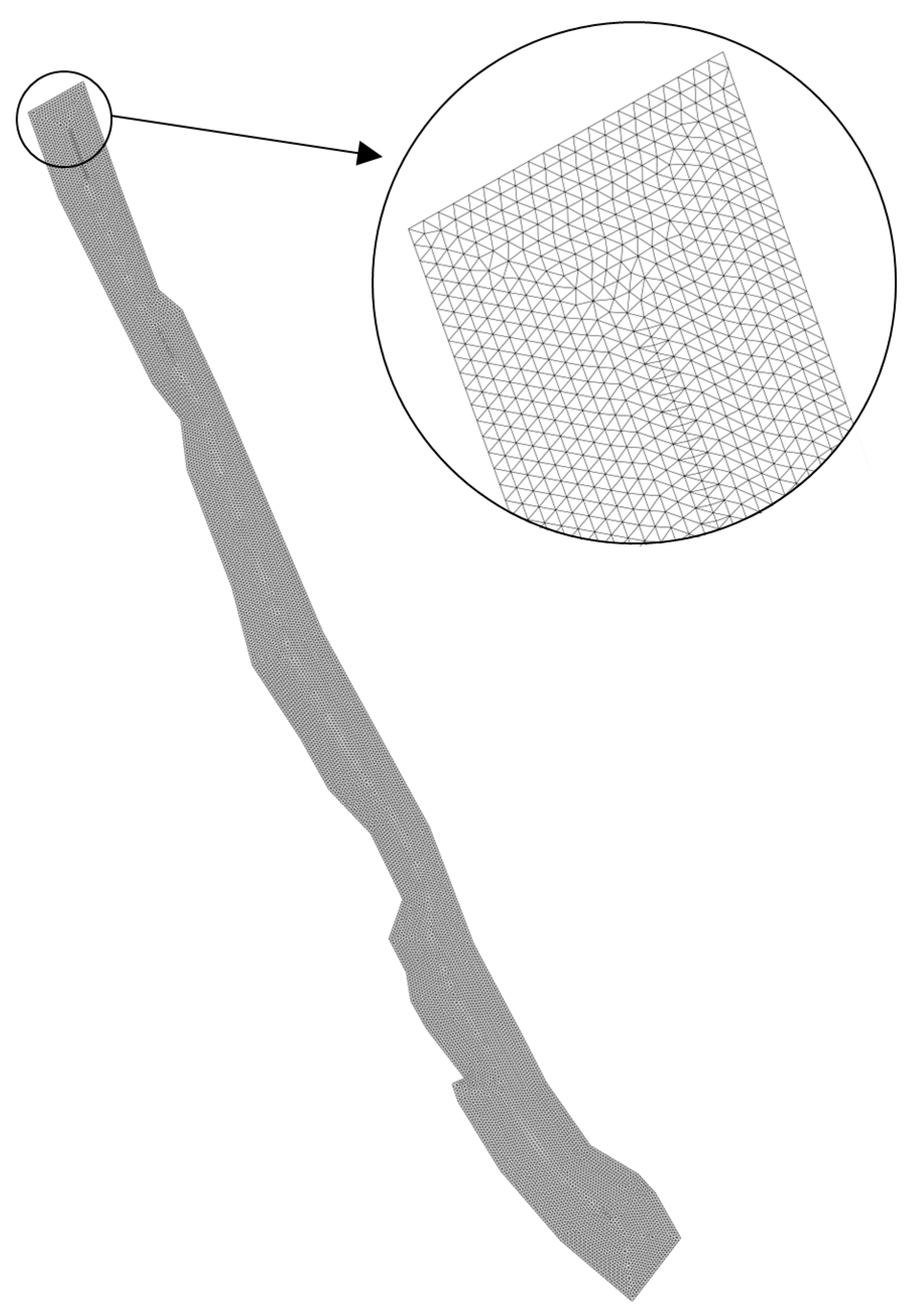

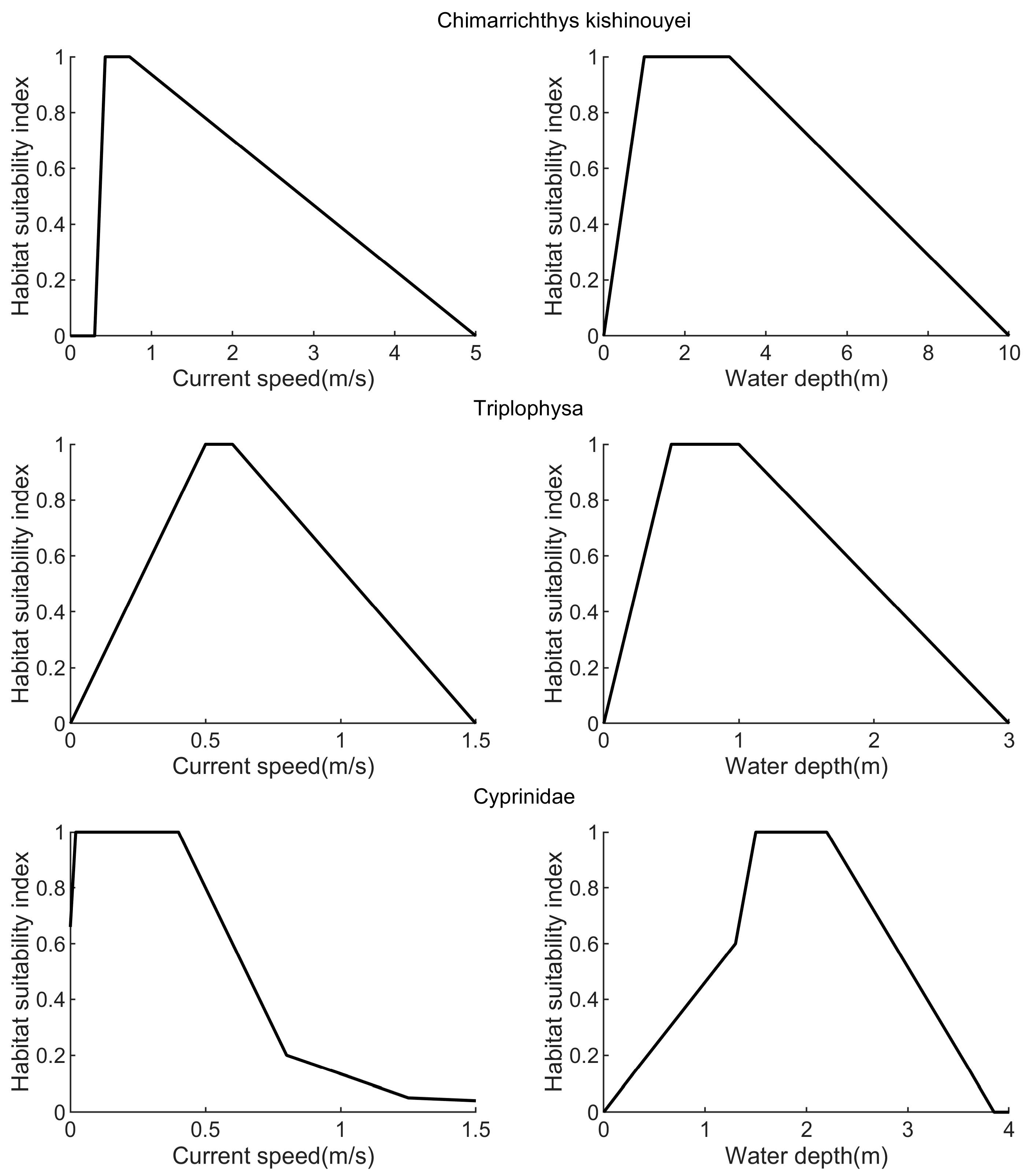

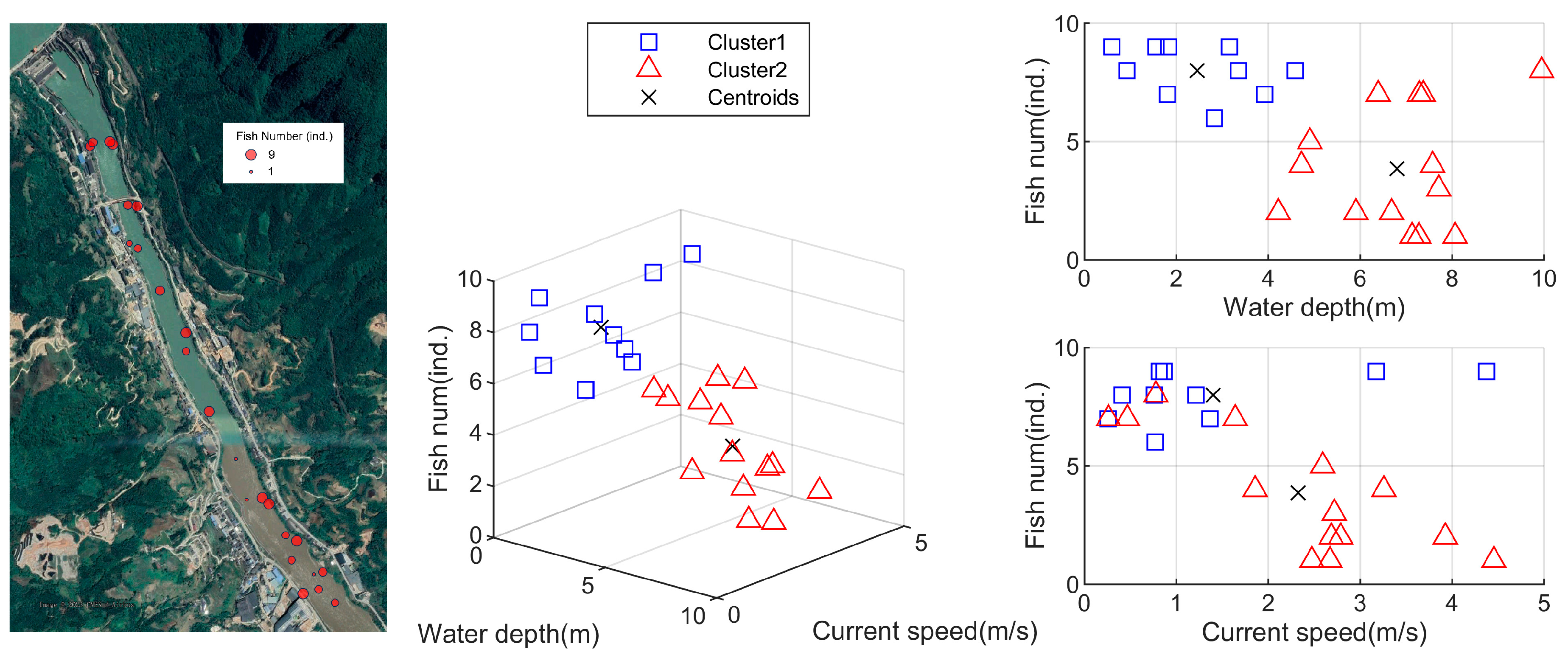
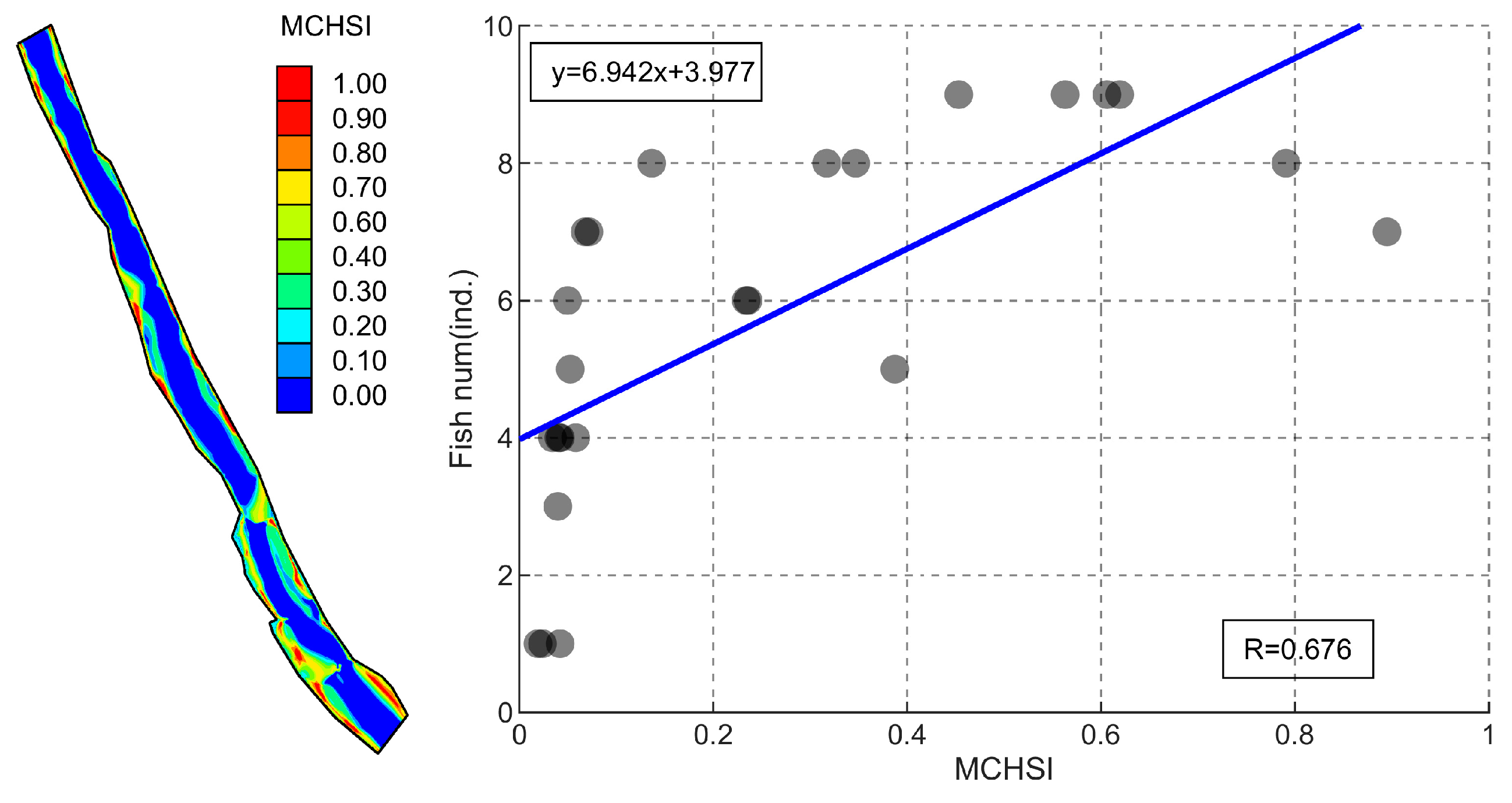
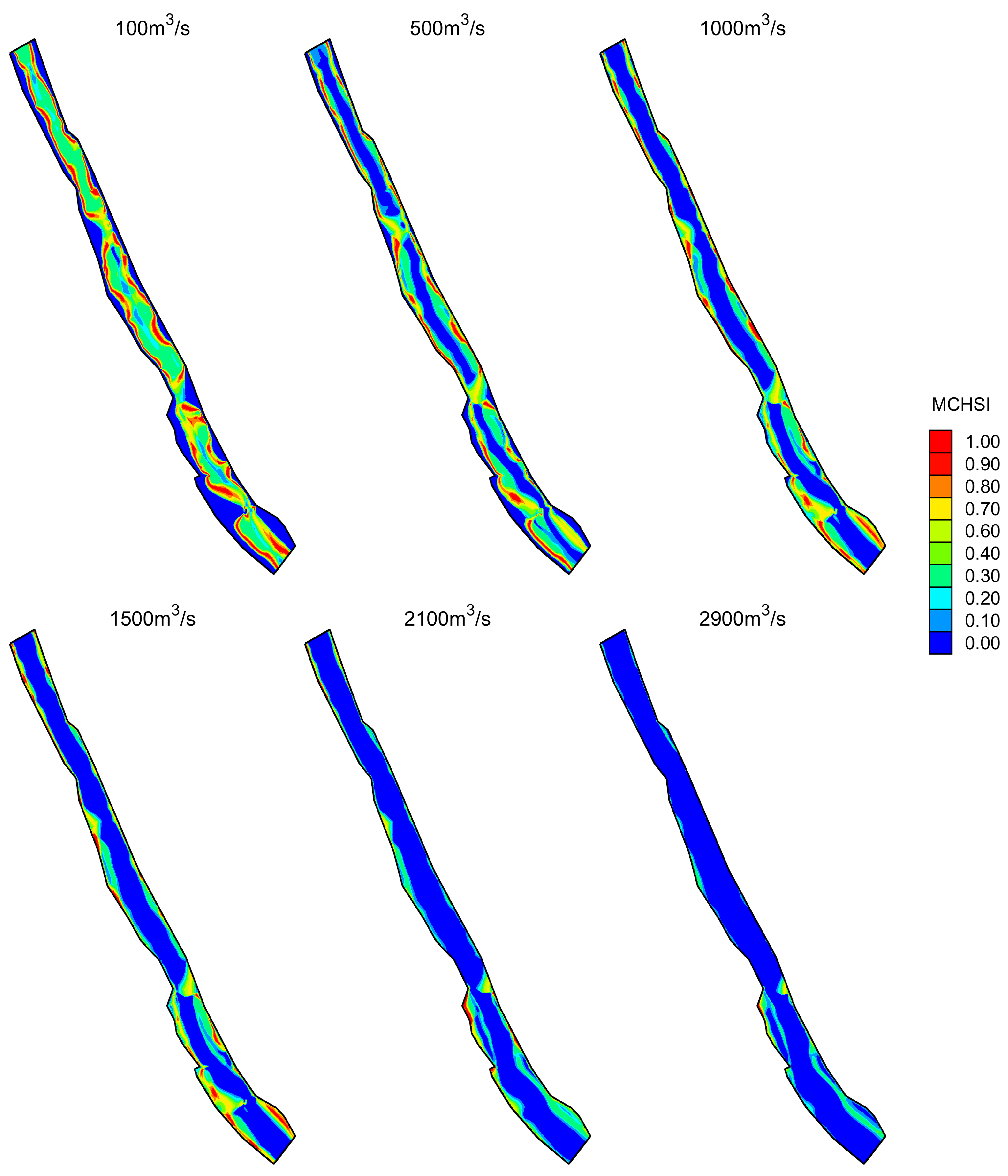
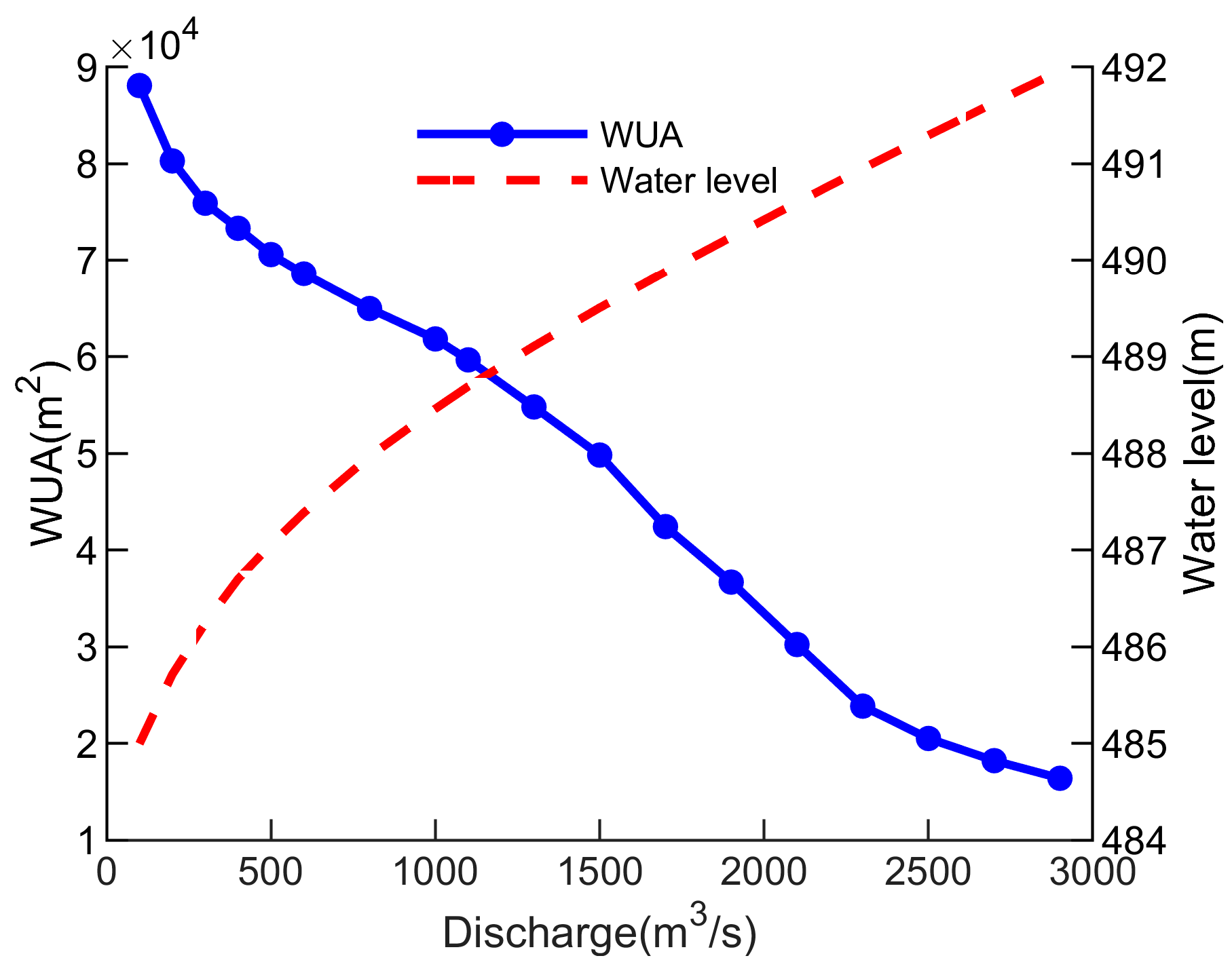
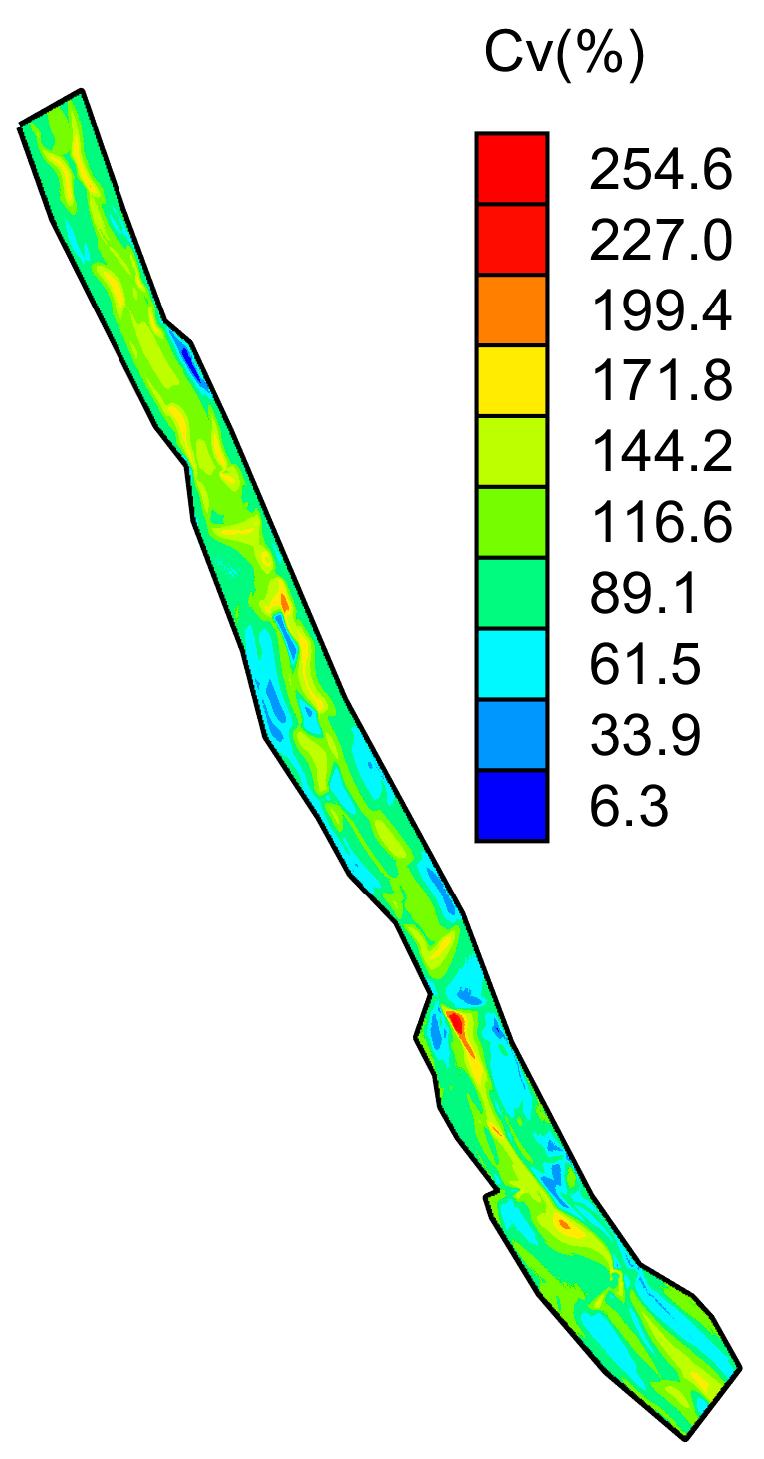

| Condition No. | Water Level Below Reservoir (m) | Reservoir Inflow (m3/s) | Reservoir Outflow (m3/s) |
|---|---|---|---|
| G1 | 522.74 | 921 | 811 |
| G2 | 522.74 | 599 | 944 |
| G3 | 522.48 | 831 | 1150 |
| G4 | 522.22 | 606 | 1310 |
| Fish Catalog | Fish Quantity | ||||
|---|---|---|---|---|---|
| Cypriniformes | Cobitidae | Noemacheilinae | Paracobitis | Homatula berezowskii | 1 |
| Triplophysa | Triplophysa hexiensis | 20 | |||
| Triplophysa bleekeri | 4 | ||||
| Cobitinae | Misgurnus | Misgurnus anguillicaudatus | 2 | ||
| Cyprinidae | Pseudorasbora | Pseudorasbora parva | 2 | ||
| Squalidus | Squalidus argentatus | 1 | |||
| Saurogobio | Saurogobio dabryi | 40 | |||
| Abbottina rivularis | 7 | ||||
| Zacco | Zacco platypus | 24 | |||
| Leuciscinae | Opsariichthys | Opsariichthys bidens | 6 | ||
| Schizothoracinae | Schizothorax | Schizothorax prenanti | 3 | ||
| Schizothorax davidi | 2 | ||||
| Goblobotinae | Gobiobotia | Gobiobotia filifer | 4 | ||
| Spinibarbus | Spinibarbus sinensis | 1 | |||
| Balitoridae | Homalopterinae | Hemimyzon | Jinshaia abbreviata | 3 | |
| Siluriformes | Bagridae | Pelteobagrus | Tachysurus vachellii | 3 | |
| Sisoridae | Glyptothorax | Glyptothorax sinensis | 6 | ||
| Euchiloglanis | Chimarrichthys kishinouyei | 10 | |||
| Amblycipitidae | Leiobagrus | Leiobagrus marginatus | 4 | ||
| Siluridae | Silurus | Silurus meridionalis | 1 | ||
| Ictaluridae | Ictalurus | Ictalurus punctatus | 2 | ||
| Catalog of Fishes | Fish Quantity Proportion | Habitat Factor | Weight |
|---|---|---|---|
| Triplophysa | PT(0.19) | Water depth (m) | WT,D |
| Current speed (m/s) | WT,V | ||
| Cyprinidae | PC(0.73) | Water depth (m) | WC,D |
| Current speed (m/s) | WC,V | ||
| Chimarrichthys kishinouyei | PE(0.08) | Water depth (m) | WE,D |
| Current speed (m/s) | WE,V |
Disclaimer/Publisher’s Note: The statements, opinions and data contained in all publications are solely those of the individual author(s) and contributor(s) and not of MDPI and/or the editor(s). MDPI and/or the editor(s) disclaim responsibility for any injury to people or property resulting from any ideas, methods, instructions or products referred to in the content. |
© 2023 by the authors. Licensee MDPI, Basel, Switzerland. This article is an open access article distributed under the terms and conditions of the Creative Commons Attribution (CC BY) license (https://creativecommons.org/licenses/by/4.0/).
Share and Cite
Huang, Y.; Wang, X.; Li, H.; Chen, F.; Chen, K.; Wang, Z.; Wang, B. Research on a Multi-Species Combined Habitat Suitability Assessment Method for Various Fish Species. Sustainability 2023, 15, 14801. https://doi.org/10.3390/su152014801
Huang Y, Wang X, Li H, Chen F, Chen K, Wang Z, Wang B. Research on a Multi-Species Combined Habitat Suitability Assessment Method for Various Fish Species. Sustainability. 2023; 15(20):14801. https://doi.org/10.3390/su152014801
Chicago/Turabian StyleHuang, Yongzeng, Xiaogang Wang, Hongze Li, Fazhan Chen, Kaixiao Chen, Zhe Wang, and Biao Wang. 2023. "Research on a Multi-Species Combined Habitat Suitability Assessment Method for Various Fish Species" Sustainability 15, no. 20: 14801. https://doi.org/10.3390/su152014801




